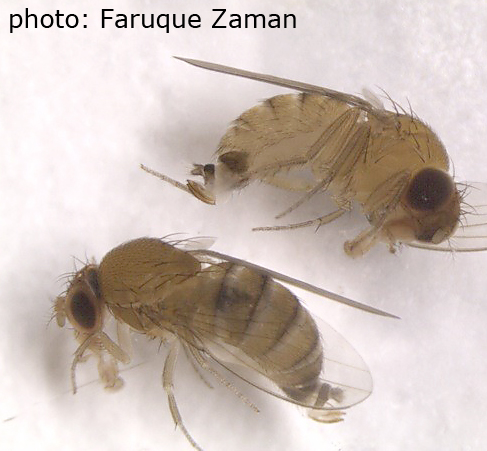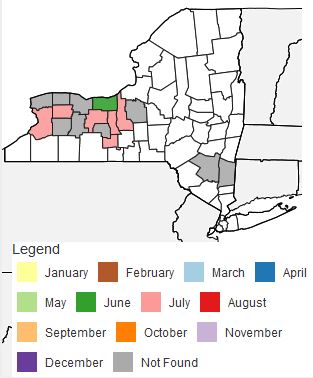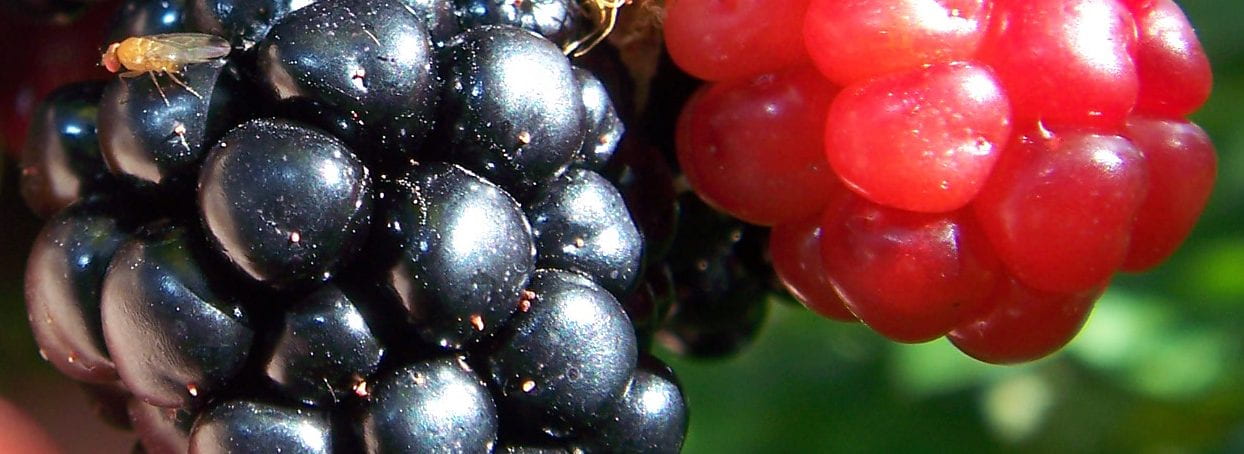One female was caught on July 20, 2015 in a trap set in a raspberry planting in Orleans County and being serviced by Liz Tee who works with Debbie Breth in the Lake Ontario Commercial Fruit Program. Although the count is very low at this site, some locations are reporting trap catches in the double digits now. Protect berries, grapes and tree fruit that are ripe and ripening. Pay attention to all practices that can be used on your farm to manage SWD. (GDD = 1382, day length = 14:53)
Category: SWD reports
Grower report – SWD in Columbia County
One female SWD and two males were caught on July 16, 2015 in traps set in blueberries in Columbia County and being monitored by the grower. This report came in courtesy of Laura McDermott, E NY Commercial Horticulture Program, who adds the site is in the southern part of Columbia County. The grower will begin a spray program for SWD on their blueberries.
First catch in Ulster County
Four male and one female SWD were caught in traps set in Ulster County and checked on July 15, 2015 by Jim O'Connell, Ulster County Cornell Cooperative Extension & the E NY Commercial Horticulture Program. One male was caught in a trap set on the edge of a blueberry planting and the rest were in a trap set in raspberries. (GDD = 1309, day length = 14:52)
First catch in Niagara County
Two males and one female were caught in traps checked on July 15, 2015 by Liz Tee who works with Debbie Breth in the Lake Ontario Commercial Fruit Program. The traps were set on the edge of a red raspberry planting in Niagara County. (GDD = 1211, day length = 15:00)
First catch in Livingston County
One male was caught in a trap set in raspberry and one female was caught in a trap set in blueberry in Livingston County. Traps were checked on July 15, 2015 by Dave Thorp, Livingston County Cornell Cooperative Extension and the insects identified by Nicole Mattoon, NYS IPM Program. (GDD = 1150, day length = 14:58)
First catch in Albany County
Three females and one male were caught in a trap set in a summer raspberry planting at a farm in Albany County. Traps were checked on July 15, 2015 by Laura McDermott, Eastern NY Commercial Horticulture Program. (GDD = 1312, day length = 14:56)
First catch in Rensselaer County
Seven females and three males were caught in an apple cider vinegar trap at a farm in Rensselaer county this week. Traps were collected on July 13, 2015 and are with the lure comparison research that Greg Loeb, Department of Entomology, Cornell University is leading. Traps are being serviced by Laura McDermott, Eastern NY Commercial Horticulture Program. The traps were in set in an Amelanchier hedgerow near strawberries. Amelanchier species are commonly known as shadbush, shadwood or shadblow, serviceberry, sarvisberry or sarvis, juneberry, saskatoon, wild pear, sugarplum or wild-plum, and chuckley pear. In nature, this genus hybridizes readily and species distinctions can be difficult.
Grower report – SWD in Tioga County
Three males and one female SWD were caught in a trap today, set in a hedgerow near a blueberry planting in Tioga County. This trap is being monitored by the blueberry grower.
The suggestion I give growers is to check traps frequently, if they plan to set traps to monitor. Frequently would be about every day. This way, not a lot of fruit flies and other insects get caught in the traps and it is easier to sort through the insect to check for SWD.
The treatment threshold is first trap catch and ripe fruit present in the planting. Keep this in mind and plan accordingly for an effective spray program that will protect your fruit for your markets.
First catch in Suffolk County
Two spotted wing Drosophila (SWD) females were caught in a trap checked on July 10, 2015 from a raspberry field in Suffolk County, Long Island, as reported by Faruque Zaman, Suffolk County Cornell Cooperative Extension. The trap was placed on the edge of the field. The other trap (inside the field) in that planting did not catch any SWD. However, in the same location, 2% of 50 ripe raspberries collected the same day had evidence of egg laying by SWD.

To date, no SWD were found in traps placed in blueberries, blackberries, and grapes. All traps were baited with whole-wheat dough and apple cider vinegar was used as drowning solution. Weather information: GDD= 1025, day length= 14:52, average temperature (7/4 – 7/10)= 69.4F, total rain fall (7/4 – 7/10) = 0.19 inch.

First catch in Erie County
Five male SWD were caught in a trap in Erie County set on the edge of a summer raspberry planting. This trap is being monitored by Sharon Bachman, Erie County Cornell Cooperative Extension, with help from the summer staff from the WNY Partnership for Regional Invasive Species Management. (GDD = 1150, day length = 15:04)


